Explore Dubai's Cable Car: A Unique Urban Adventure
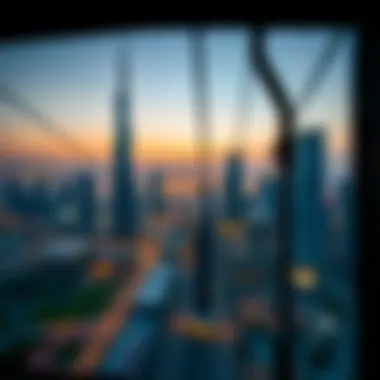
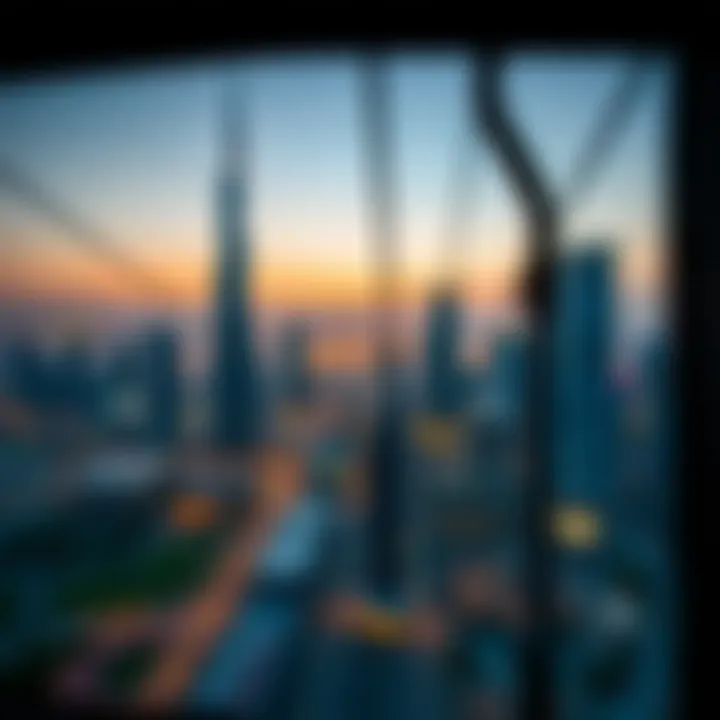
Intro
Dubai stands as a prime example of modern marvels fused with a rich tapestry of history. Among its many attractions, the cable car system emerges as a standout feature of the city. It is not merely a mode of transportation; it's an experience that connects residents and tourists to breathtaking views and pivotal locations across this bustling metropolis.
The cable car system's role in Dubai extends far beyond its operational convenience. This network has become intertwined with the fabric of urban life, reflecting the city's ever-evolving landscape and aspirations. It serves as a bridge between innovation and sustainability, showcasing the emirate's commitment to progressive public transport solutions.
In the following sections, we take a closer look at the various aspects surrounding the cable car system—its engineering feats, its impact on tourism, real estate dynamics, and environmental significance. Each facet offers an in-depth understanding of why this system is pivotal in shaping not just Dubai's physical landscape but also its cultural and economic narrative.
Foreword to Dubai's Cable Car System
The implementation of a cable car system in Dubai isn’t just another amenity in an already lavish city; it’s a landmark in public transport innovation that intertwines practicality with a touch of artistry. Residents and visitors alike can enjoy a ride that covers both emotional satisfaction and logistical efficiency. This section dives deep into the fundamentals that make Dubai’s cable car experience significant, exploring its implications for modern transportation and urban life.
Overview and Significance
As Dubai positions itself as a leading global city, the cable car system plays a crucial role in reshaping the transportation landscape. Here are several key points that outline its significance:
- Enhanced Connectivity: The cable car offers a unique way to navigate through Dubai’s bustling districts, allowing passengers to soar above traffic and enjoy panoramic views. By facilitating easier access to shopping districts, tourist attractions, and residential areas, it enhances the city’s connectivity.
- Touristic Appeal: A ride in the sky not only serves a functional purpose but also provides an unforgettable experience that lures tourists. The allure of stunning vistas over iconic landmarks like the Burj Khalifa and the Palm Jumeirah translates into a compelling reason for tourists to favor the city.
- Sustainability: In a world increasingly focused on reducing carbon footprints, the cable car stands as an eco-friendly alternative to traditional transport. This contributes to Dubai’s initiatives aimed at promoting sustainable urban development.
Interestingly, this system seems to represent a bridge—not merely between one point to another, but also between modernity and the romanticism associated with flight. Much like the birds that grace Dubai’s skies, riders experience a sense of freedom and wonder, something not easily replicated by other forms of transport.
Historical Background
The story of Dubai’s cable car system didn’t begin with the first cable strung tight between two towers; rather, it stems from a vision aimed at evolving the city’s transportation options. The early discussions about implementing a cable car system took root a little over a decade ago, largely inspired by similar successful projects around the globe. The planners, keen on expanding multifaceted transport solutions, examined various systems in cities like Medellín and Hong Kong, capturing ideas on operational efficiency and community integration.
In 2019, the project was set into motion, driven by the urge to innovate and to revolutionize urban mobility. Initially, challenges were faced during planning. Concerns related to the project’s alignment within the bustling cityscape required keen engineering foresight. Today, however, it stands as a testament to Dubai’s commitment to integrating cutting-edge transport solutions that remain sensitive to the dynamics of urban development and historical influences.
The Dubai cable car system is not just about traversing distances; it represents a narrative of connection, community, and the spirit of modernity.
This exploration establishes the groundwork for comprehending how a seemingly simple cable car can become a vital element in a city's tapestry, weaving in threads of technology, heritage, and vision for the future.
Technical Specifications
The technical specifications of Dubai's cable car system serve as the backbone of its operational reliability and user experience. This section dissects the critical elements that contribute to its efficiency, safety, and overall appeal. By understanding these specifications, one can appreciate not only the engineering feats behind the system but also the benefits they provide to various stakeholders, including investors, property managers, and home buyers.
Engineering Innovations
Dubai’s cable car system is a marvel of modern engineering. It employs state-of-the-art materials and technologies that ensure durability and efficiency while providing breathtaking views over the city. One notable innovation is the use of lightweight composite materials in the construction of the cabins. These cabins are designed to withstand harsh weather while minimizing the load on the supporting cable system.
Moreover, the configuration of the suspension cables has been meticulously planned to optimize the stability of the system. This allows for longer spans between towers, reducing visual clutter in the landscape and enhancing the aesthetic experience for the passengers. Additionally, the drive mechanisms are equipped with advanced safety features that maintain the right tension on cables, further ensuring smooth operation.
Another breakthrough is the integration of smart technology within the control systems. Real-time data analytics help operators monitor the system's performance and preemptively resolve issues, thereby minimizing downtime. As such, both technology and innovation converge to create a seamless travel experience.
Safety Protocols
Safety is a cornerstone of the cable car experience; it cannot be overstated. The implementation of strict safety protocols is paramount for the operational integrity of the system. These protocols are informed by local and international standards, making sure that every ride is as safe as possible.
Regular maintenance checks play a pivotal role in ensuring the system's reliability. Trained technicians conduct thorough inspections of both the cabins and the cables on a frequent basis. In addition, emergency procedures are well-defined, with evacuation plans in place should an unexpected situation arise. Signs are strategically placed within the cabins and at stations, guiding passengers effectively in case of an emergency.
Another important aspect is the surveillance and monitoring systems installed across the network. Cameras and sensors are meticulously positioned to oversee the cabins' operation, allowing for immediate reactions if an anomaly is detected. These proactive measures underline the commitment to passenger safety, ensuring that users can enjoy their ride without a worry in the world.
In sum, the technical specifications of Dubai's cable car system showcase a robust framework that intertwines innovation with safety—a combination that offers both thrilling experiences and peace of mind to users. The culmination of these elements not only highlights the significance of the system in Dubai’s urban fabric but also strengthens the investment potential for stakeholders looking to engage with an evolving city landscape.
"Safety protocols are not just codes; they are heartbeat of operational success in systems like Dubai's cable cars."
For more technical insights on cable car systems, you can check the following resources: Wikipedia - Cable Cars, Britannica's Insights.
Routing and Connectivity
The routing and connectivity of Dubai's cable car system play a vital role in enhancing the overall transportation framework of the city. This system not only provides an alternative mode of travel but also serves as a backbone for interconnecting different areas within the bustling metropolis. The significance of well-planned routes cannot be overstated, as they cater to commuter needs while maximizing operational efficiency.
Key Routes in the Network
Dubai's cable car network boasts several key routes strategically designed to serve both residents and tourists. Each route connects major landmarks, residential areas, and commercial hubs.
- Dubai Marina Route: This route runs parallel to the scenic waterfront, offering stunning views of luxury yachts and the iconic skyline. It connects leisure spots to business districts, making it perfect for both tourists looking for a scenic ride and locals commuting to work.
- Palm Jumeirah Link: This route crosses over the stunning Palm Jumeirah island, providing passengers with a unique perspective of luxury villas and hotels nestled along the coast. The aerial view from this segment is a must-see for anyone in Dubai.
- Downtown Connector: Connecting the Dubai Mall and the Burj Khalifa, this route serves as a conduit for tourists eager to explore the city’s hottest attractions. Its position fosters an easy flow of foot traffic between shopping, dining, and cultural experiences.
In addition to these primary routes, segments are being considered to reach upcoming developments, ensuring connectivity as the city expands.
Interconnectivity with Other Transport Systems
Interconnectivity is essential in modern urban planning. The cable car system in Dubai is ingeniously integrated with existing transport systems, enhancing the ease and efficiency of travel across the city. For instance:
- Synergistic Networks: The cable car integrates with the Dubai Metro and bus services, allowing seamless transfers that benefit commuters. By offering carefully synchronized timetables, riders can switch between modes of transport without excessive wait times.
- Accessibility to Transit Hubs: The cable car stations are situated near major transport hubs. This accessibility simplifies the journey for riders, as they can quickly catch a train or bus after their aerial adventure. Notable stations connect to major thoroughfares and residential areas, expanding the network's reach.
"A well-connected transport system not only promotes commuting ease but also enhances the overall real estate value in adjacent areas."
- Future Expansion: As construction of new transport links continues, the cable car system is expected to evolve even further. Planned extensions aim to connect newer neighborhoods and developments, adhering to the growing demand from both residents and tourists.
This intricate web of routes and interconnections signifies that the cable car system is more than just a scenic ride; it is a fundamental piece of Dubai's urban mobility puzzle, strategically benefiting the city’s infrastructure and contributing to its sustainable growth.
For further insights on Dubai's transport system, check out the official Dubai Roads and Transport Authority: rta.ae or explore additional discussions on reddit.com.
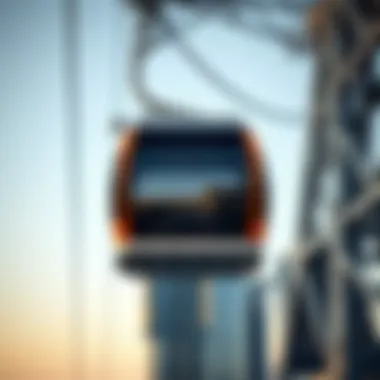
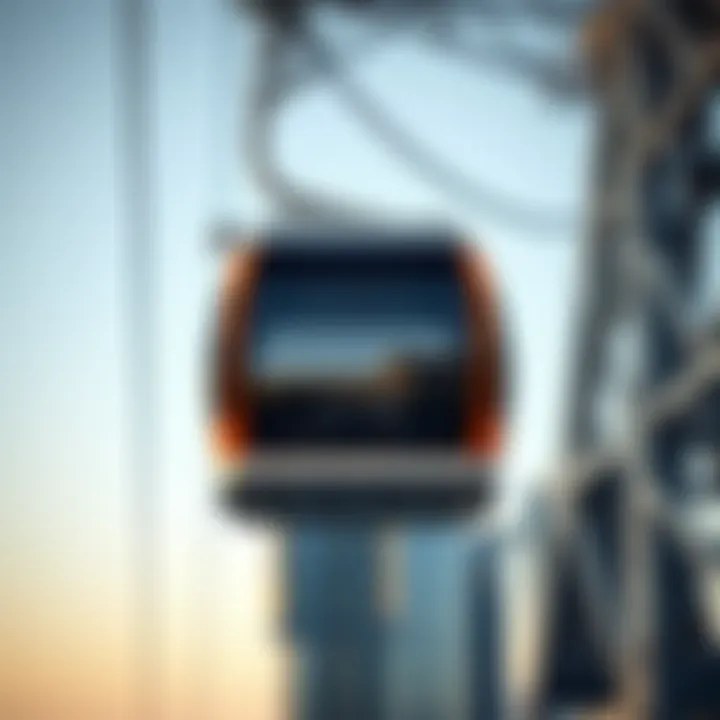
Experiential Overview
In examining the cable car experience in Dubai, we grasp not just its functionality but also the unique sensations it elicits from its riders. An experiential overview provides insight into why this transport system has garnered applause and attention alike. For many, it's more than simply a means of getting from point A to point B. It embodies adventure, scenic beauty, and an opportunity to see the city through a different lens.
Onboard Experience
When one steps into a cable car in Dubai, they embark on a sensory journey like no other. The car gently sways, giving an exhilarating feeling of floating against the backdrop of the city's skyline. Inside, the cabin is often designed with sleek, modern finishes. Transparent walls allow for panoramic views, drawing the eye towards the horizon. The feeling is one of euphoria, especially as the car rises higher and the ground below diminishes.
Beyond just a ride, the onboard experience includes various features aimed at enhancing rider comfort. Those who ride can enjoy climate control—a necessity in the often scorching temperatures of Dubai. Access to information screens offers educational tidbits about the landmarks passing by, adding a layer of enrichment to the journey.
Moreover, the ride encourages interactivity among passengers. Travelers often engage in conversations, surrounded by others who share the same sense of wonder at their surroundings.
Scenic Highlights
As the cable car glides through the air, it reveals the breathtaking vistas that are quintessential to Dubai. The views from the cable car are nothing short of astounding. On a clear day, passengers are treated to vista over the sprawling desert sands on one side and the azure waters of the Arabian Gulf on the other. From this elevated vantage point, iconic structures such as the Burj Khalifa and the Palm Jumeirah come into full view, taking on an ethereal quality.
Another aspect worth mentioning is the blooming gardens and parks scattered throughout the city which become visible. This juxtaposition of natural beauty and urban architecture serves not only as a delight for the eyes but as a reminder of the masterful planning that has gone into Dubai’s development.
"Riding the cable car isn't just a transport experience; it's a relationship with the city, a bond formed from above as you gaze upon Dubai's marvels."
Every twist and turn offers opportunities to capture memorable photos, preserving moments that will last a lifetime. Whether it’s the vibrant skyline or an unexpected sunset casting golden hues across the horizon, the scenic highlights are unforgettable. Overall, the cable car offers an experience that marries thrill with tranquility, making it an exhilarating way to explore Dubai's stunning scenery.
The elements of the onboard experience and the scenic highlights entwine, forming a narrative of exploration and discovery. This complex web of sensory and visual impacts contribute significantly to the appeal of Dubai's cable car journey and highlights its growing importance in promoting tourism and urban connectivity within the city.
Influence on Real Estate Development
The influence of Dubai's cable car system on real estate development cannot be understated. This innovative transport solution is reshaping the urban landscape, delivering not only a means of travel but also driving economic growth and attracting investment. The implications for property management, residential growth, and urban planning are significant, carving out a new dimension in how individuals and corporations engage with the city.
Proximity to Key Developments
Dubai's cable car network acts as a magnet for development. The close tie to key attractions like the Burj Khalifa and Dubai Mall sets the stage for a thriving real estate market. Being close to this system can drastically enhance a property's appeal.
- Accessibility: Properties near cable car stations enjoy better access to the city’s attractions. A short ride can connect potential buyers or tenants to retail hubs, entertainment zones, and employment centers.
- New Projects: As part of urban expansion, fresh residential developments are popping up within the cable car's sphere of influence. Developers are keen to capitalize on the increasing foot traffic and the promise that such infrastructure brings.
- Urban Regeneration: Existing neighborhoods often see a face-lift as funds pour in to upgrade amenities around cable car stops. This regeneration can lead to an upsurge in both aesthetic appeal and local commerce.
Impact on Property Values
The introduction of the cable car system is seen as a game-changer for property values in Dubai. When considering an investment, potential buyers scrutinize accessibility and amenities, which the cable car system abundantly provides.
- Market Valuation: Studies have shown that properties near successful transit lines, like cable cars, tend to inflate in value over time. This upward trend is visible as increased interest translates to heightened demand and higher prices.
- Long-term Investment: Investors are eyeing properties near cable car stations as a sound long-term strategy. Greater connectivity typically leads to better capital appreciation.
"Infrastructure improvements can easily elevate urban property markets, making cable car systems a major player in the housing landscape."
- Attractiveness to Buyers: A property’s connection to the cable car adds a unique selling proposition. This enhances its desirability among buyers willing to pay a premium for convenience and access.
In summary, the interplay between Dubai's cable car system and real estate highlights how transportation can serve as a catalyst for urban growth. The development of housing and commercial spaces is increasingly tuned to the rhythms of this dynamic transit system, setting the stage for a future where accessibility defines property value.
Tourism and Economic Impact
The intersection of tourism and economic growth is a cornerstone in understanding how Dubai's cable car system influences the urban fabric of the city. As the demand for unique and memorable tourist experiences rises, the cable car emerges as a pivotal attraction that not only enhances the urban experience but also stimulates various economic sectors. This synergy is critical, particularly for investors and property managers looking to navigate the ever-evolving landscape of Dubai’s tourism-driven economy.
Attraction for Tourists
Dubai’s cable car experience offers an accessibility that invites both residents and visitors alike to take in the magnificent skyline and picturesque surroundings from above. Many tourists are drawn to this venture for several compelling reasons:
- A Unique Perspective: The aerial views provide a bird’s-eye view of iconic landmarks like the Burj Khalifa and Palm Jumeirah, making photographers and social media enthusiasts swoon.
- Adventure and Relaxation: The exhilarating nature of gliding through the air juxtaposed with the serene surroundings creates a hybrid experience of thrill and tranquility.
- Cultural and Recreational Fusion: The cable car system often connects tourists to cultural hubs, theme parks, and recreational areas, maximizing their enjoyment and promoting longer stays.
As the global travel market competes for attention, unique experiences such as a cable car ride in Dubai may sway potential travelers in favor of visiting this vibrant metropolis. Moreover, enhanced connectivity through these attractions encourages tourists to explore beyond the typical hotspots, cultivating a more robust and diverse economic impact on smaller businesses in peripheral neighborhoods.
Economic Contributions
The economic ramifications of the cable car system extend far beyond mere ticket sales. The cumulative impact ripples through various sectors that contribute significantly to the city's overall financial health. Consider the following factors:
- Job Creation: The operational needs of the cable car system generate jobs in maintenance, customer service, and management. This, in turn, stimulates the job market, reducing unemployment rates.
- Boosting Local Businesses: Increased foot traffic around cable car stations encourages patrons to explore nearby shops, restaurants, and entertainment options, thereby directly enhancing local financial activity.
- Real Estate Value Enhancement: Proximity to the cable car system can affect property values positively, attracting both investors and buyers who recognize the potential for growth in areas served by the public transport system.
"The cable car not only transforms the landscape but also serves as a powerful catalyst for economic prosperity across Dubai by unlocking the potential of local businesses."
In summary, the cable car system enriches both the tourist experience and the economic landscape of Dubai, serving as a prime example of how innovative transportation solutions can yield substantial benefits for urban centers across the globe.
Environmental Considerations
The significance of environmental considerations in the context of Dubai's cable car system cannot be overstated. As urban areas continue to expand, the need for sustainable and eco-friendly transportation options becomes crucial. The cable car not only serves as an innovative solution to address traffic congestion but also aligns with the global push towards adopting environmentally responsible practices. By weaving it into Dubai's urban fabric, the cable car demonstrates a commitment to reducing the carbon footprint while providing effective transit options. Understanding these aspects is essential for stakeholders, including investors, property managers, and home buyers, as they navigate the development landscape in this bustling city.
Sustainability Practices
The cable car system in Dubai upholds several sustainability practices aimed at minimizing its impact on the environment. One of the primary practices involves utilizing energy-efficient technologies, contributing to a reduced energy consumption in comparison to conventional modes of transportation. The integration of renewable energy sources into operations, such as solar power, is an emerging strategy that could further enhance these sustainability goals.
Moreover, the materials used in construction prioritize durability and recyclability. Efforts to limit emissions during the construction phase underscore the system's commitment to preservation and ecological sensitivity.
In addition, the cable car supports the local economy by promoting green jobs. For instance, technicians trained in maintaining energy-efficient systems contribute directly to the sustainability ethos of the project. This holistic approach enables the project not only to serve as an efficient transportation solution but also to pave the way for a greener future.
Minimal Environmental Disruption
When it comes to the installation and operation of the cable car, one of the key advantages is its minimal environmental disruption. Unlike traditional roadways which can require extensive land clearing, the cable car operates with less physical footprint by utilizing elevated structures. This design significantly reduces the amount of land needed for development and helps preserve native ecosystems around the city.
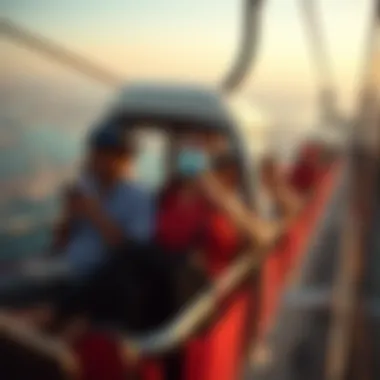
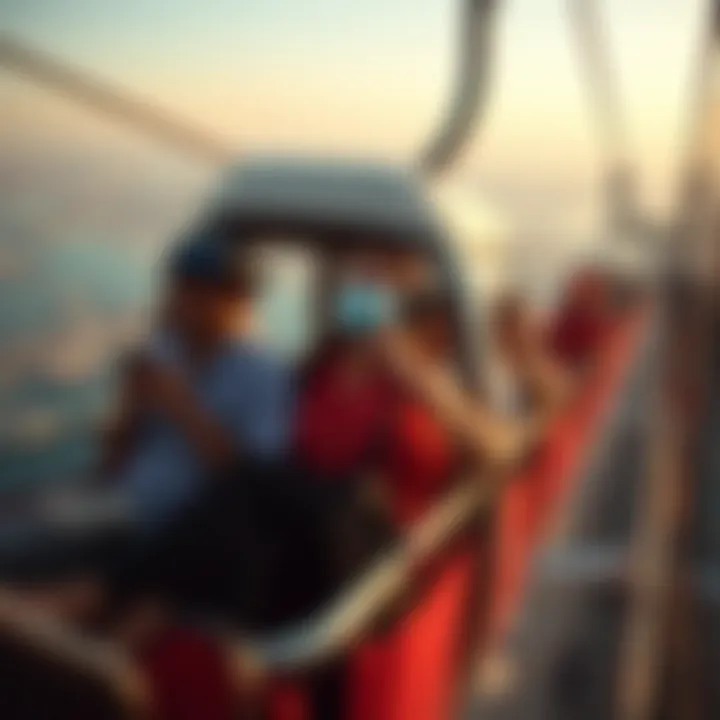
The planning phase conducted extensive environmental impact assessments, ensuring that the proposed routes avoid sensitive areas. Vegetation corridors remain intact, allowing wildlife to thrive. This strategy not only helps maintain biodiversity but also enhances the charm and aesthetic appeal of Dubai’s urban scenery.
Furthermore, the use of quiet, low-emission gondolas adds a layer of environmental benefit as they glide through the city. Riders can appreciate the views without the accompanying noise pollution that typical urban transport generates.
These considerations serve to reinforce the cable car's position as a revolutionary transport solution, harmonizing the modern demands of urban living with the critical requirement of maintaining environmental integrity.
"A sustainable cable car system not only transforms transit but also safeguards the very essence of our urban landscape."
In a dynamic city like Dubai, such measures reflect deep foresight and responsibility, promising a future where public transport coexists with nature itself.
Future Developments and Expansion Plans
The future of Dubai's cable car system is not just an extension of its current routes, but a reflection of the city's vision for comprehensive connectivity and modernization. As Dubai continues to rise as a leading global city, the cable car system holds significant promise for enhancing urban mobility, driving tourism, and promoting sustainable practices.
Proposed Extensions
Proposed extensions for the cable car network are set to open new avenues for exploration within the city. One of the most talked-about extensions connects the cable car system to iconic landmarks like Dubai Mall and Burj Khalifa. This connection would provide tourists and residents a seamless experience while enhancing foot traffic to the area. Additionally, plans have emerged to draw routes towards Al Ain and other suburban developments. This strategic move is geared towards easing congestion in traditional transport modes while offering a scenic glide over the city’s sprawling landscape.
As part of these expansions, ongoing discussions involve integrating modern technologies such as real-time tracking. It is aimed to provide riders with live updates on wait times, adding to the convenience factor. Extending the cable car system can also facilitate access to less traveled areas, bridging gaps in public transport especially in growing neighborhoods.
“An extended cable car network could redefine commuting in Dubai, turning a mundane trip into a unique experience.”
Integration with Upcoming Urban Projects
The integration of the cable car system with upcoming urban projects is another layer of its future significance. Future developments such as the Expo 2020 site have already placed emphasis on utilizing innovative transport methods to foster urban connectivity. For instance, plans are in place for the cable car phase to serve the Expo area, intertwining with the many pavilions and events designed for visitors. This not only enhances accessibility but also contributes to a greater narrative of sustainability and modern transport solutions.
Moreover, as Dubai invests heavily in smart city initiatives, the cable car system can play a central role. Integrating with projects focused on green spaces, such as parks and recreational areas, can ensure that visitors experience both nature and urban development in harmony. This foresight encourages a steady influx of visitors who seek to enjoy the rich blend of culture, leisure, and leisure that Dubai now promises.
Comparative Analysis with Global Systems
In today’s swiftly evolving transportation landscape, understanding what makes a system successful can play a significant role in planning and implementing effective public transport solutions. The analysis of Dubai's cable car system against established global counterparts provides insights into operational efficiencies, technological advancements, and user engagement strategies that might inspire further development.
Lessons from Established Cable Car Systems
Examining successful cable car systems around the world, such as the Ngong Ping Skyrail in Hong Kong or the Merida Cable Car in Venezuela, reveals valuable lessons for Dubai. These systems not only enhance connectivity but also enrich the tourist experience. For example, the Ngong Ping Skyrail integrates cultural attractions within its routes, allowing visitors to soak in both natural and man-made wonders. Similarly, Dubai can foster partnerships with nearby attractions to create comprehensive packages, making the ride an integral part of the visitor experience.
- Integration with Landmarks: Linking cable car routes with notable attractions fosters a seamless experience.
- User Frequency Analysis: Studies from these systems show that peak usage hours are critical for scheduling. The ability to manage demand can lead to enhanced rider satisfaction.
- Community Engagement: Active involvement from local communities can drive usage and promote cultural awareness. Established systems often serve as educational platforms.
Innovations Worth Adapting
Innovation plays a pivotal role in enhancing the efficiency and appeal of cable car systems. For instance, the 36th Street Cable Car in New York City employs state-of-the-art technology for luminous notifications, allowing users to track their cab's movement in real-time. Dubai can adapt similar innovations to elevate its system.
- Real-Time Tracking: Implementing user-friendly mobile apps offering real-time updates could enhance commuter experience and assist in planning trips.
- Energy-Efficient Operations: Many European cable systems have begun using renewable energy sources for operations, providing not just cost savings but significant ecological benefits as well.
- Luxury Additions: A nod to the scenic views and opulence Dubai is known for, incorporating glass floors or luxury cabins can significantly elevate the experience and draw a more upscale crowd.
By looking outward and learning from the successes and failures of global cable car systems, Dubai can refine its strategies to not just connect points A and B, but to create a fully enriched urban mobility experience.
In closing, the comparative analysis of global systems sheds light on various paths Dubai might take. Each lesson learned is a potential avenue for growth and enhancement of Dubai's own cable car experience.
Challenges and Solutions
In any urban transport system, addressing challenges head-on is crucial for long-term sustainability and operational efficiency. For Dubai's cable car system, which is touted not only for its engineering prowess but also for its ability to enhance the urban experience, understanding the challenges it faces reveals the complexity behind its day-to-day operations. In this section, we will delve deeper into these operational challenges along with the strategic solutions implemented to overcome them.
Operational Challenges Faced
The operations of Dubai's cable car system aren’t just a walk in the park. Several challenges have emerged since the inception of this system. These include:
- Weather-related Issues: Dubai's extreme heat presents unique challenges. High temperatures can affect both the mechanical parts of the cable cars and the comfort level of passengers.
- Technological Integration: As the system evolves, integrating advanced technologies while maintaining connectivity with existing infrastructure can present its own set of difficulties.
- Safety Concerns: Ensuring passenger safety and compliance with international safety standards is non-negotiable, and any lapses could lead to infamous consequences.
- Maintenance Demands: The regular wear and tear on cable car mechanisms necessitates a constant schedule of inspections and repairs, which can be expensive and time-consuming.
- Public Perception and Trust: Building and maintaining public confidence is vital. Incidents—be they minor or major—tend to linger longer in public memory, impacting usage rates.
The importance of identifying and addressing these challenges cannot be overstated. They not only affect operational efficiency but also impact ridership and overall perception of the service.
Strategic Solutions Implemented
In response to these challenges, several strategic solutions have been put in place:
- Advanced Climate Controls: Innovations in materials and design have allowed for improved climate control inside the cable cars. Special coatings can deflect heat, while enhanced ventilation systems ensure comfort during the sweltering months.
- Seamless Tech Upgrades: A phased approach has been adopted for tech integration. This ensures that the system doesn’t face disruptions while new technologies are implemented. Collaborations with tech companies have also accelerated this process.
- Robust Safety Protocols: Regular safety drills and training programs for staff enhance preparedness. In addition, rigorous adherence to ISO standards helps in building an operational system that stands tall both nationally and internationally.
- Scheduled Maintenance Plans: Predictive maintenance technologies use data analytics to anticipate issues before they become troublesome. This proactive approach minimizes downtime and keeps the system running smoothly.
- Community Engagement Initiatives: Efforts to educate the public about safety measures, operational protocols, and ongoing improvements have fostered trust. Survey platforms and feedback mechanisms have been established to capture user experiences, further improving service delivery.
Implementing these strategies reflects a commitment to excellence that transcends challenges, ensuring that the cable car remains a cornerstone of Dubai's transport ecosystem.
The challenges faced by the cable car system are not roadblocks; they are stepping stones to continual improvement and innovation in urban transport.
For further information, you can explore more at Wikipedia or Britannica.
Public Perception and User Feedback
Understanding public perception and gathering user feedback is vital for any urban transportation system, especially for a city as dynamic as Dubai. The cable car system not only enhances the city's skyline but also plays a key role in how residents and tourists navigate the sprawling urban landscape. The interests of various stakeholders—investors, property managers, and potential home buyers—are intricately linked to how the public views this transport initiative, as it directly influences property values, tourism, and overall satisfaction with the city’s infrastructure.
Surveys and Data Analysis
Surveys are a rich source of insights into how users perceive the cable car experience. When conducting surveys, key areas of focus include:
- Service Efficiency: How well does the cable car system meet the needs of its users in terms of speed and reliability?
- User Satisfaction: What do riders think about the overall experience, from boarding to disembarking?
- Safety Perceptions: How confident are users in the safety protocols in place?
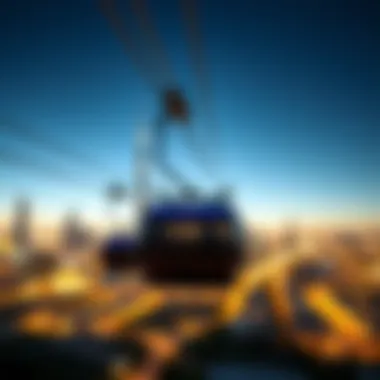
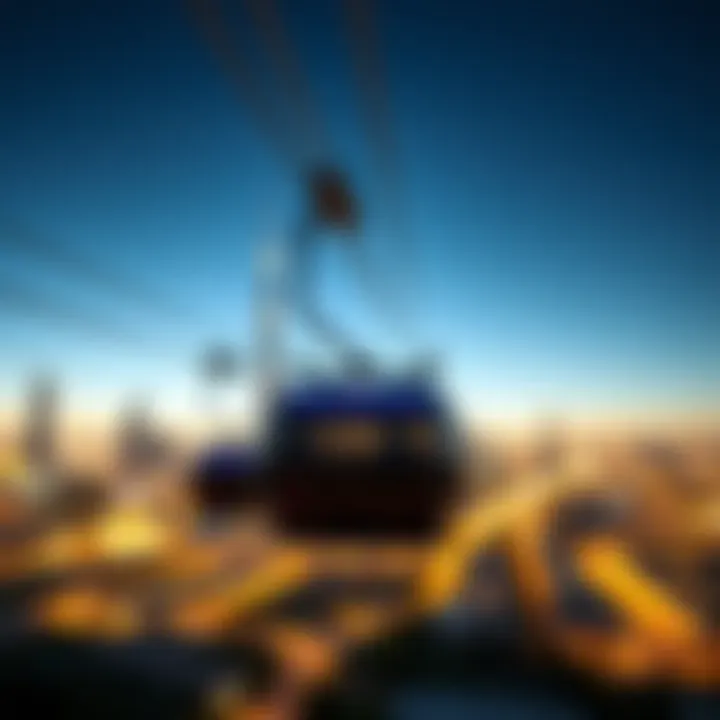
Data analysis often reveals trends and patterns that inform future improvements. For instance, a significant portion of riders may express concerns about waiting times during peak hours. Conversely, positive feedback might emerge regarding the panoramic views offered. This information can direct operational changes or marketing strategies.
Another compelling aspect of surveys is demographic breakdown. Understanding whether tourists or local commuters favor the cable car could help tailor services to either group’s specific needs, ensuring a more user-centric approach. With online platforms making it easier to collect feedback quickly, operators can respond effectively to emerging trends.
Testimonials from Riders
Rider testimonials provide qualitative insights that surveys can sometimes miss. Here are some key considerations:
- Personal Experience: Riders often share vivid descriptions of their journey, capturing both the thrill of the ride and the sights viewed from above. For example, a tourist may describe how the scenic vistas of Dubai's iconic skyline made their day trip unforgettable.
- Narratives of Convenience: Many commuters highlight the cable car's role in their daily routines, noting how it provides a convenient connection to other transportation methods, thus easing their travel experience across the city.
"Riding the cable car is like having a front-row seat to the beauty of Dubai! It has truly changed how I see the city."
- Suggestions for Improvement: Testimonials often come with suggestions, revealing areas for development. For instance, riders might comment on the necessity for more frequent service during specific hours or express a preference for more informative signage while in transit.
When riders share their stories, they become advocates for the cable car system. Each narrative adds a layer of depth to understanding the public's experience, shaping the way the system is perceived by potential users and stakeholders alike. Consequently, these anecdotes can influence both the cable car's operational strategies and its reputation in the larger context of Dubai's transportation framework.
In summary, public perceptions and user feedback are crucial touchstones for assessing the success of Dubai's cable car initiative. By leveraging surveys and rider testimonials, stakeholders can ensure that the cable car system remains a beloved cornerstone of the city’s ever-evolving transport landscape.
Integration with Smart City Initiatives
As urban landscapes evolve, cities across the globe are embracing the concept of smart cities—where technology and data play pivotal roles in enhancing the quality of life. Dubai is at the forefront of this movement, and its cable car system is no exception. The integration of cable cars within Dubai's greater smart city initiatives exemplifies the city's vision for a sustainable and efficient urban environment.
Contribution to Smart Mobility
Dubai's cable car system significantly contributes to smart mobility by providing an alternative mode of transport that complements existing transportation networks. By linking various districts and major attractions, the cable cars create an efficient transit solution that not only reduces traffic congestion but also encourages the use of public transport.
- Enhanced Connectivity: The cable car system facilitates smooth transfers between different transport modes like buses and metros. Riders can seamlessly switch from a bus to a cable car without the hassle of long waiting times.
- Real-Time Tracking: Smart technology enables passengers to track cable car schedules through mobile applications. This insight into wait times improves the overall travel experience and aids passengers in planning their journeys more efficiently.
- Sustainability Focus: Committed to reducing its carbon footprint, Dubai’s cable car network employs energy-efficient technologies, significantly lowering emissions compared to traditional vehicular transport. This not only aligns with Dubai's commitment to sustainability but also enhances the appeal for eco-conscious riders.
"The movement towards smart mobility is not just about technology; it's about rethinking urban spaces to make them more livable and less congested."
Future Technologies in Cable Systems
Looking ahead, the future of cable cars in Dubai is intertwined with advancements in technology that promise to elevate the user experience and operational efficiency even further.
- Automated Systems: Upcoming cable lines may feature fully automated systems that require minimal human intervention. This would ensure consistent service while significantly reducing labor costs.
- Smart Monitoring: Incorporating IoT (Internet of Things) devices allows for real-time maintenance alerts, minimizing downtime and ensuring that cables remain in optimal condition.
- Interactive Stations: Future cable car stations may incorporate interactive displays that provide more than just travel information. They could serve as educational hubs showcasing Dubai’s culture, history, and environmental initiatives, offering riders a richer experience.
- Greater Accessibility: Advanced technology will likely facilitate increased accessibility for all riders, including those with disabilities. Innovations in design and application will make cable cars an inclusive mode of transportation.
The strategic integration of cable cars into Dubai’s smart city infrastructure is indicative of a forward-thinking approach. This initiative not only addresses immediate urban transport challenges but also reflects a broader commitment to sustainable development and technological advancement. Investors, property managers, and potential homeowners can therefore recognize the cable car system not just as a transport option, but as an essential facet of a thriving urban ecosystem.
Cultural Reflections and Impact
The integration of a cable car system in Dubai transcends its practical purpose of transportation; it serves as a canvas displaying the city’s cultural ethos. This section explores the multifaceted nature of this infrastructure and its compelling influence on local artistry, tourism, and community identity. Cable cars do not merely glide over the skyline; they symbolize a convergence of modernity and tradition, representing how Dubai weaves its historical narrative into its rapidly growing urban landscape.
Cultural Events Hosted
Dubai’s cable car system isn’t just about getting from point A to B; it’s about creating a space for cultural engagement. Numerous events are hosted along its routes, drawing locals and tourists alike. One of the most notable occurrences is the Dubai Cable Car Festival, which showcases local musicians, art exhibitors, and culinary delights. This event has transformed the cable car stations into vibrant cultural hubs, enabling artists to display their works, while performers captivate audiences during their rides.
Aside from these festivals, themed nights and special rides during festive seasons enliven the experience. For instance, during Ramadan or the New Year celebrations, the cable cars host lighting displays that celebrate the occasion, providing spectators with breathtaking views. Riders often find themselves part of an experience that blends relaxation with rich cultural insights, encouraging a sense of community and belonging.
Influence on Local Art and Tourism
When discussing tourism, it’s crucial to recognize how the cable car system has significantly impacted local art scenes. Artists are increasingly inspired by the sweeping views of the city, which act as backdrops for their work. The dynamic scenery visible from the cable cars has motivated local painters and photographers to create pieces that reflect the city’s changing face, merging its historical elements with its futuristic aspirations.
Moreover, the attractions along the cable car routes have become significant tourist hotspots. Places like Al Ain Tower and Dubai Parks have seen increased foot traffic, leading to greater visibility for local artisans and craftsmen who operate shops nearby. Visitors are not just eager to ride the cable car for the vistas; they’re equally excited to explore the attached cultural exhibits and art installations that tell the story of Dubai’s heritage.
"The cable cars have become a lifeline, connecting not just places but also stories, art, and communities across the city."
In essence, the cable car system is a remarkable facilitator of cultural cohesion. The artistic endeavors fostered by this infrastructure have implications far beyond aesthetic appreciation. They help cultivate an environment where local artists thrive, and tourists gain an authentic glimpse into Dubai’s rich tapestry of culture. As these cultural reflections continue to flourish alongside the cable car experience, they enhance both the emotional and economic aspects of Dubai’s ever-evolving identity.
Epilogue: The Future of Cable Cars in Dubai
The conclusion of this article focuses on the future of cable cars in Dubai, a topic that holds substantial significance as the city continues to evolve. The cable car system stands not only as a mode of transport but as a catalyst for broader development across Dubai. Its ability to seamlessly connect different urban zones enhances accessibility and convenience, contributing to a more integrated public transport layout that serves residents and tourists alike.
Summarizing Current Trends
In recent years, the trend of integrating cable cars into urban transit networks has gained momentum worldwide. Dubai's approach showcases how these systems can complement existing modes of transportation, such as the metro and bus services. The emphasis on eco-friendly designs and technologies resonates with the global push for sustainability in urban planning.
- Enhanced user experience with panoramic views and a significantly smoother ride
- Adopted smart technologies in ticketing and monitoring
- Positive feedback loop: increasing use fosters more investment
As financial resources go towards maintaining and expanding the cable car system, stakeholders are keen on diversifying services to attract various user groups. From tourists eager to experience bird's-eye views to daily commuters looking for fast transit options, the array of possibilities contributes to the broader vibrancy of urban life.
Vision for the Next Decade
Looking ahead, the vision for cable cars in Dubai appears promising. With ambitious plans for development, there are a few key areas that are worth noting.
First, expansion into underserved areas could greatly enhance public transport reach. Areas like Jumeirah and Al Quoz could all benefit from direct cable links, promoting economic activity and residential desirability.
Next, the embrace of technological advancements will likely transform operations. Rolling out features like augmented reality informational screens in gondolas can enhance the rider experience by providing insight into points of interest along the route. Additionally, integrating apps that track real-time cable car status or allow for easy ticket purchases could further elevate the convenience factor.
Lastly, there's undeniable potential for the cable car system to play a pivotal role in key events and festivities, further embedding itself into the cultural fabric of Dubai.
"The future landscape of Dubai's public transport could look dramatically different, depending largely on how effectively we leverage our existing resources like the cable car system."
In summary, the future of cable cars in Dubai seems bright, running parallel to the city's ambitions of becoming a global leader in smart urban living. As this transport system develops, the potential benefits—ranging from economic growth to improved environmental impacts—cannot be overstated.
For more insights on urban transport innovations, consider visiting:
Investors and stakeholders should keep an eye on these developments; the evolution of Dubai's cable car experiences shall offer a blueprint for future projects worldwide.















